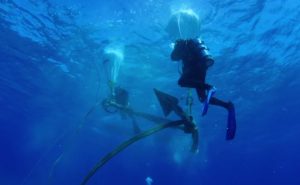Even before the space race between the United States and the Soviet Union turned into a full sprint, space exploration was providing us with loads of new information about the universe. Yet there was one astronaut who discovered something so big, he didn’t want to share it.
While on a mission sponsored by NASA, astronaut Gordon Cooper was tasked with gathering valuable insight into the workings of our galaxy. Only, while orbiting the planet, he observed something on Earth’s surface—something that he would keep a secret for nearly five decades. Recently, however, that secret was exposed for all the world to see…

When Gordon Cooper of Oklahoma was about seven years old, his dad, an Army colonel, allowed him to ride along in his airplane—and briefly let the young boy take the controls. This simple act would spark Cooper’s lifelong fascination with flying.
Before he turned 32, Cooper had served in the Marines, the Air Force, and as a test pilot on Edwards Air Force Base. There he suggested industry-changing improvements to the F-106B Delta Dart jet fighter. Then, he received an unbelievable offer…
It was 1959 when NASA invited Cooper to Washington, D.C. as a potential candidate for the Mercury Project. The project sought to put a man into Earth’s orbit and then return him safely, and Cooper was an ideal candidate.

After placing him on a shortlist of 109 potential candidates, NASA selected Cooper as one of seven men for the program. In May 1963, he conducted his first mission aboard the Faith 7, a craft so small it could only fit someone under five feet and 11 inches tall.
The instructions NASA gave the enthusiastic Oklahoman were simple: go into space solo, survive, and study zero gravity’s prolonged effects on the human body. At least, this was the mission as far as the public was concerned…
The project started out a rousing success. From May 15 to 16, for just about 34 hours, Cooper orbited Earth, becoming the first astronaut to sleep in space. But then, in the midst of this enormous accomplishment, disaster nearly struck…

As the Faith 7 returned to Earth, the automatic piloting system malfunctioned. Experienced flier that he was, Cooper didn’t panic. Instead, he grabbed the controls and maneuvered the spacecraft into a perfect landing on a waiting aircraft carrier. His mission was complete… or was it?
Though the public didn’t know it at the time, Cooper’s mission also involved taking pictures. “Man, all I do is take pictures, pictures, pictures,” he said in a message to ground control. “I’m up to 5,245 now.” But he wasn’t just looking for eye-catching images…

Cooper’s camera was actually equipped to detect magnetic aberrations along the Earth’s surface. This allowed him to secretly look for Soviet nuclear bases or submarines off the coast of the United States—and, boy, did he uncover some eye-opening stuff.
In the process of searching for secret nuclear bases, Cooper also detected hundreds of anomalies near the Caribbean, which he carefully charted in his small Faith 7 spacecraft. These aberrations, he noticed, weren’t big enough to be nuclear sites—not by a long shot. So, what were they?

Cooper wasn’t sure what he’d spotted from space, but he had a few ideas—and they required further research. For an unknown reason, he never told NASA or the Department of Defense about these strange anomalies. He decided to embark on his own personal mission…
Once safely back on Earth, Cooper started investigating his findings. The anomalies he saw all seemed bunched around old trading routes that had been highly trafficked by Spanish ships. Surely this was more than a coincidence…

Cooper quickly made the connection from the shipping routes to possible shipwrecks, and he researched everything he could regarding centuries-old shipwrecks. Eventually, he felt confident that he had, in fact, charted some of them from space! What did this all mean?
The world would have to wait to find out. He had a long and successful career—including a mission on the Gemini 5, during which he spent 190 hours in space. Still, Cooper never had the time to truly explore his findings. Then, as he grew older, time started running out…

Afflicted with Parkinson’s and nearing the end of his days, Cooper didn’t want his secret discovery to be for naught, so he phoned his friend, Darrell Miklos. An explorer who had experience hunting for rocket ship debris, Miklos would be able to investigate on Cooper’s behalf.

Cooper passed away in 2004, but by then his map was safely in his friend’s possession. At long last, it was time for Miklos to investigate what Gordon Cooper had seen from space all of those decades ago. Was there any truth to it?
“I believed Gordon 100 percent,” Miklos told Parade magazine. “I didn’t need proof.” Neither did the Discovery Channel, which, along with Miklos, created Cooper’s Treasure, a 2017 TV show that documented the investigation.

So, what did they find? On one journey, Miklos and his crew traveled to a spot on Cooper’s map looking for evidence of a shipwreck. With the help of deep-sea diving gear, they surveyed the ocean’s floor, hoping for a sign…
Sure enough, the crew uncovered a massive anchor! They hauled it to their deck, and soon after they realized that it was from the era of Christopher Columbus. This made it an extremely valuable artifact from the past!

By mid-2017, Miklos and his crew had searched five spots on Cooper’s map, and at all five, they found evidence of a shipwreck. With hundreds more points left to explore, what other treasures might be waiting for Miklos to uncover?

Miklos planned to visit the rest of the locations, but it would take time. Still, as he told Newsweek, “I hear Gordon all the time in the back of my head: ‘You’re on the right trail!’” And it sure looked that way.

Regardless of whether Miklos would be able to spend the next few decades searching for his friend’s discoveries remains to be seen. Still, you know that Gordon Cooper—the Oklahoma boy who reached the stars—would be happy to see his secret finally paid off!

Gordon Cooper may have been a lifelong teller of tall tales, but it looked like his shipwreck map really panned out.
Source: boredom therapy
Ask me anything
Explore related questions





